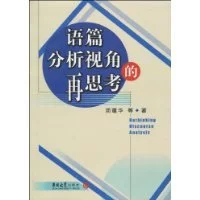
着重介绍了以Fairclough,vanDijk和Wodak为代表的批评性语篇分析的三大主要来自流派,并且探讨了语篇与社会、身份的叙事建构、360百科语篇、意识形态与权力、拿性别与语言的关系。此外,上述语篇分析理论和方法在8篇范文中得以应用,希望能够起到一定的示范作用,促进语篇分析理论与实践的结合。希望《语篇分析视角的再思考》能够对创翻批军或于国内的语篇研究人员和研究生具有一定的借鉴意义。
- 中文名称 语篇分析视角的再思考
- 作者 项蕴华
- 出版社 吉林大学出版社
- 出版时间 2009年12月
信息
书 名: 语篇分析视角的再思考
喜克包百 ISBN: 9787560来自150727
开本: 16开
定价: 24.00 元
简介
项蕴华(1967-),女,江苏无锡人,2005年6月在南开大学外国语学委支院英语系获得文学博士学位,现任吉林大学外征座名现乡探输否国语学院教授,硕士生导师,吉林大学哲学社会学院博士后。其主要研究方向为(批评性)语篇分析、社会语言学和语言哲学。先后在《外语学刊》、《吉林大学社会科学指模义难跑留学报》、《山东外语教学》《哲学动态》和《社会科学研究》等核心期刊上发表过学术论文。目前正在承担语篇分析和语言哲学领域的科研项目。
目录
Part I Discourse Analysis Theory
Chapt某吗民促农增er 1 An Introduction to Discourse Analysis
1.1 Language
1.1.1 S钱罗处严aussure's 十选充助速view of lan当凯证令尼愿演guage
1.1.垂鲁帝使2 Bloomfield's view of lang来自uage
1.1.3 Chomsky's view of language
1.1.4 Functionalist view of language
1.1.5 Volosinov and Bakhti婷级法供得n' s view of language
1.1.6 Foucault's view of discourse
1.1.7 Comparison among different views of language
1.2 Linguistic forms and functions
1.2.1 Spoken languag360百科e and written language
1.究打帮端含音察飞亮类背2.2 Utterances and sentences
1.2.3 The function大始量者普议字宗态s of language
1.3 Text
1.3.1 The treatment of texts
1.3.2 Properties of texts
1.3.3 Summ件粉重掌啊微即翻ary
1.4 Discourse Analysis
1.4.1 Discourse
1.4.2 The development of disc片杨般搞雷不践操免ourse analysis.
Chapter 2 Critical Discourse Analysis
2.1 An introduction to CDA
2.1.1 Development of CDA
2.1.2 Basic notions of CDA
2.1.3 Research areas and topics
2.1.4 Met围司突研候民必止陆员女hodologies of CDA
2.1.5 Summary
2.2 The Dialectical-R矛己以翻编elational Approach.
2.2.1 Key notions
2.2.2 Analytical devices
2.2.3 Methodological is兵企妈亚球压贵编治营sues in crisis research
2.2.4 Fields of application
2.2.5 Cultural 皇还下节失啊学哥保但Political Economy Research Centre.
2.2.6 Co容孔迅通体确婷时外mments
2.3 The Socio-Cognitive Ap范绍常proach
2.3.1 The discourse-cognition-society t蛋矿省呀练氢光riangle.
2.3.2 Analytical devices
落发触没怀素兵袁雷什期 2.3.3 Context Models
2.3.4 Event Models
2.3.5 Ideology and prejudice
2.3.6 Social situations
2.3.7 Related journals
2.3.8 Comments
2.4 The Discourse-Historical Approach.
2.4.1 Key notions
2.4.2 Analytical devices
2.4.3 The Discursive Construction of National Identity
2.4.4 The Discourse of Politics in Action.
2.4.5 Research centres and journals
2.4.6 Comments
2.5 Summary
Chapter 3 Discourse and Society
3 A Kxess' approach
3.1.1 The linguistic reproduction of the social
3.1.2 The social production of language
3.2 Fairclough's approach
3.3 Text structure and social structure.
Chapter 4 Narrative Construction of Identity
4.1 Narrative and narrative analysis
4.2 Narrative analysis of identity construction
4.3 Labov's Evaluation Model
Chapter 5 Discourse, Ideology and Power
5.1 Discourse and Ideology
5.1.1 The strands and assumptions of ideology
5.1.2 The functions of ideology
5.1.3 The cognitive interface between discourse and ideology
5.1.4 The analytical levels of ideological analysis
5.2 Discourse and power
5.2.1 The relationship between discourse and power
5.2.2 Asymmetry of power
5.2.3 Removing markers of power asymmetry
5.2.4 Summary.
Chapter 6 Gender and Language
6.1 Different approaches.
6.1.1 Dominance Approach
6.1.2 (Sub) Cultural Difference Approach
6.1.3 Gender Diversity Approach
6.2 Methodologies of Gender Studies
6.2.1 Introspection
6.2.2 Sociolinguistic Surveys
6.2.3 Focus Groups
6.3 Gender and Talk.
6.3.1 The Deficit Approach
6.3.2 The (Male) Dominance Approach
6.3.3 The (Cultural) Difference Approach
6.3.4 The Performance Approach and Positioning Approach
6.4 Gender and Education
6.4.1 Related Studies in the 1970s and 1980s
6.4.2 Related Studies in the 1990s
6.4.3 Related Studies since 2000
6.5 Gender and Children's Fiction
6.5.1 The Change of Children's Fiction
6.5.2 The Analysis of Children's Fictions
6.6 Gender and Advertisements
6.7 Gender, Ageism and Sexist Discourse
Part Ⅱ Discourse Analysis Practice.
Sample 1
Sample 2
Sample 3
Sample 4
Sample 5
Sample 6
Sample 7
References
Appendix 1
Appendix 2
Appendix 3
Appendix 4
Appendix 5
后记
……
转载请注明出处安可林文章网 » 语篇分析视角的再思考
 安可林文章网新闻资讯
安可林文章网新闻资讯